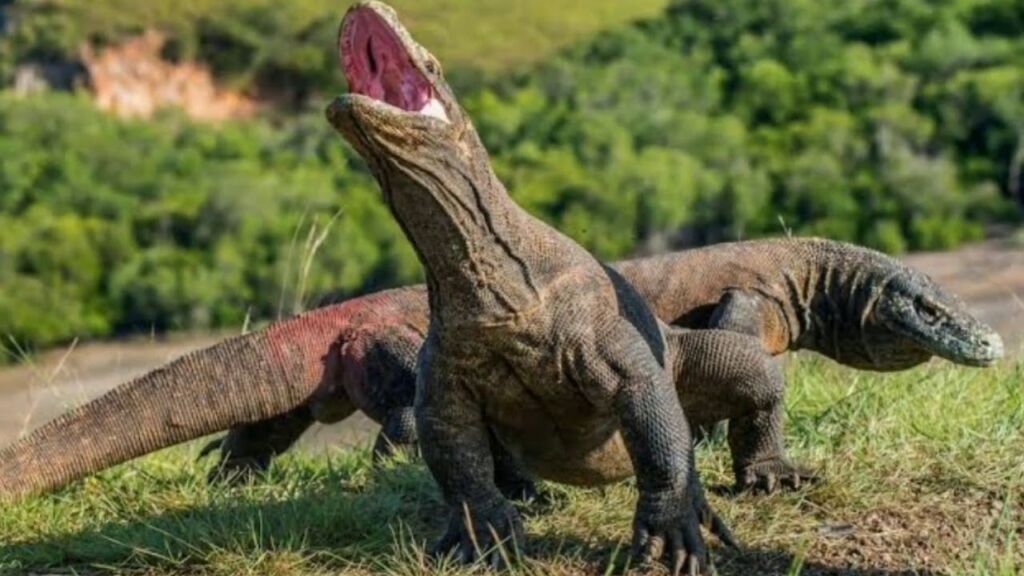Taxonomy and evolution
Varanus is the sole living genus in Varanidae. The earless monitor of Borneo, Lanthanotus borneensis, is a close relative but belongs to a separate family and is not a true monitor. Fossils attributable to Varanus appear by the Miocene, though varanoid lineages are much older. The Pleistocene giant Varanus priscus, often called megalania, lived in Australia and likely exceeded 3.5 meters in length, with larger estimates debated. Modern monitors are grouped into several informal subgenera that reflect ecology and geography, including desert specialists, semi-aquatic giants, arboreal forest forms, and dwarf Australian species.
Etymology and names
The generic name Varanus derives from the Arabic word waral, meaning lizard. In English they are called monitors or monitor lizards, possibly influenced by early notions that they warned of danger. Across their range, they have rich local nomenclature reflecting deep cultural familiarity, from biawak in Malay to goanna in Australia and butaan for some Philippine species.
Distribution and habitats
Monitor lizards occur naturally in sub-Saharan Africa, South and Southeast Asia, and Australia, extending to many islands of the western Pacific. They inhabit environments from dunes and rocky escarpments to lowland rainforests, alpine forests, floodplains, and mangrove coasts. Semi-aquatic species thrive along rivers and lakes and frequently enter cities, while arboreal species occupy forest canopies. A few populations are introduced outside their native ranges, with the Nile monitor established in parts of Florida.
Morphology and physiology
Monitors have elongated skulls with recurved teeth designed to seize and tear prey. Their forked tongues and well-developed vomeronasal organs underpin acute chemical sensing. Compared with most lizards, they maintain high aerobic capacity, supported by efficient lungs and a robust cardiovascular system that enables bursts of speed and sustained activity. Research has identified venom components in the oral glands of several species, which can affect blood pressure and coagulation in prey. For humans, the primary risks are mechanical trauma and secondary infection rather than systemic envenomation.
Behavior and cognition
Monitor lizards are diurnal and highly active, using sun basking to reach optimal body temperatures for hunting. They exhibit notable cognitive abilities among reptiles, including spatial memory, rapid learning of feeding routines, and flexible foraging strategies. Males often engage in ritualized wrestling, standing bipedally and grappling for dominance. Many species are solitary outside breeding, though home ranges can overlap and resource-rich areas may draw multiple individuals.
Diet and hunting
Most monitor lizards are opportunistic carnivores. They consume insects, crustaceans, fish, amphibians, other reptiles, birds and their eggs, and small to medium mammals, and they readily scavenge carrion. Larger species can subdue relatively big prey using ambush, a powerful bite, and ripping motions of the head and neck. A handful of species in the Philippines, such as Varanus olivaceus and Varanus bitatawa, are primarily frugivorous as adults yet retain carnivorous capabilities, an unusual strategy among large lizards.
Reproduction and life history
All monitors are oviparous. Females lay clutches that commonly range from 5 to 20 eggs, with large species producing 30 or more. Incubation can last several months, and some species actively nest in termite mounds, exploiting their stable temperature and humidity. Sexual maturity varies widely, arriving within a few years in small species and later in large species. In captivity, Komodo dragons have produced viable offspring via parthenogenesis, highlighting reproductive plasticity. Longevity typically spans 8 to 20 years in the wild and can exceed 25 to 30 years in large species under human care.
Diversity of species
The genus Varanus includes about 80 recognized species spread across multiple ecological niches.
Komodo dragon Varanus komodoensis — the largest living lizard, up to around 3 meters and 70 to 90 kilograms, endemic to the Lesser Sunda Islands of Indonesia.
Asian water monitor Varanus salvator — a widespread semi-aquatic species in South and Southeast Asia, often reaching 2 to 2.5 meters.
Nile monitor Varanus niloticus — a powerful swimmer across sub-Saharan Africa, notorious for raiding crocodile nests.
Perentie Varanus giganteus — Australia’s largest monitor, a fast-running predator of arid regions, reaching about 2.5 meters.
Desert, savannah, and rock monitors of Africa — including V. exanthematicus, V. albigularis, and V. griseus, medium to large terrestrial predators.
Emerald tree monitors of New Guinea — V. prasinus and relatives, arboreal specialists with prehensile tails.
Dwarf Australian monitors — the odatria group, such as V. acanthurus and the tiny V. brevicauda and V. sparnus at 20 to 60 centimeters total length.
Human history and cultural significance
Komodo dragons were formally described in the early 20th century, captivating global audiences and transforming scientific understanding of giant lizards. Indigenous cultures in Australia and Melanesia incorporate monitors into hunting traditions, art, and stories, and Australian goannas figure prominently in Aboriginal lore. In Southeast Asia, semi-aquatic monitors live alongside people in canals and parks, where they both fascinate and alarm urban residents. Television and documentary films have popularized monitor behavior, while zoos have developed sophisticated husbandry to meet their complex needs.
Conservation status and threats
Threats include habitat loss and fragmentation, hunting for meat and skins, persecution as pests, road mortality, and illegal collection for the pet trade. Many species are regulated under CITES to control international trade. Conservation status varies widely, from Least Concern for widespread species to Vulnerable or Endangered for island endemics with tiny ranges. The Komodo dragon, with a restricted distribution and susceptibility to habitat change, is of particular concern. Effective measures include protected areas, community-based management, enforcement against trafficking, and research to guide population monitoring.
Urban ecology and invasive populations
Semi-aquatic species such as the Asian water monitor readily adapt to human-modified waterways, feeding on fish, crustaceans, and refuse. Their presence can help control rodents but also creates conflict when they enter residential zones or are fed by people. Outside their native ranges, monitors can become invasive. The Nile monitor has formed localized populations in Florida, where it preys on native wildlife and competes with local predators, necessitating management.
Handling, safety, and ethics
Wild monitors should not be approached or fed. They defend themselves with bites, clawing, and tail strikes, which can cause deep lacerations. Any bite warrants medical attention to clean the wound and monitor for infection. Keeping monitors in captivity demands large, enriched enclosures with precise heat and light gradients, a varied diet, and experienced veterinary care. Ethical considerations discourage impulse purchasing and the illegal capture of wild animals, emphasizing captive-bred sourcing and long-term commitment.
Research frontiers
Active areas of study include varanid venom composition and function, biomechanics of locomotion and ventilation, thermal physiology under climate change, landscape genetics across island archipelagos, and the cognitive ecology of foraging and navigation. Conservation science focuses on population viability in fragmented habitats, human-wildlife coexistence in cities, and the impacts of trade policy on wild harvest pressure.
Interesting facts
Some monitors, including Komodo dragons and lace monitors, can swim long distances, facilitating island dispersal.
Several New Guinea species are predominantly fruit eaters, an unusual dietary shift among large predatory lizards.
Termite mounds function as natural incubators for eggs due to stable internal temperatures.
Males often wrestle bipedally, locking forelimbs and pushing each other to the ground in dominance contests.
Documented cases of parthenogenesis in Komodo dragons in zoos produced all-male offspring due to their sex chromosome system.
Numbers and statistics
Recognized species — about 80.
Smallest sizes — around 20 centimeters total length in the tiniest Australian dwarfs.
Largest sizes — Komodo dragons typically up to about 3 meters; most large species are 1.5 to 2.5 meters.
Typical masses — small species under 1 kilogram, large species from 10 to 30 kilograms, with exceptionally heavy Komodo males exceeding 70 to 80 kilograms.
Clutch sizes — commonly 5 to 20 eggs, occasionally over 30 in the largest species.
Longevity — roughly 8 to 20 years in the wild, often 20 to 30 years in human care for large species.
Legal status and trade
International trade in monitors and their products is regulated. Many species are listed in CITES Appendix II, allowing controlled trade with permits, while the most vulnerable may be more strictly protected nationally. Historical skin trade targeted large species like the water and savannah monitors, leading to quotas and monitoring. Today, the live trade centers on captive-bred individuals for zoos and experienced keepers, with growing emphasis on transparency and welfare.
Ecological roles
Monitors occupy pivotal positions as mesopredators and, in some systems, apex predators. By preying on rodents, insects, and other vertebrates, and by scavenging carcasses, they influence nutrient cycling and disease dynamics. Their movements link aquatic and terrestrial food webs, particularly in mangrove and floodplain habitats. Loss of monitors can trigger trophic shifts, including increases in agricultural pests and changes in scavenger communities.
Health and disease
Like many reptiles, monitors can carry Salmonella, posing a hygiene risk if handled improperly. Ectoparasites and endoparasites are common in the wild, and captive animals are prone to metabolic bone disease without correct UVB lighting and dietary minerals. Emerging concerns include pathogens transmitted at wildlife markets and the effects of environmental contaminants in urban waterways on semi-aquatic species.
Komodo dragon spotlight
Endemic to a handful of Indonesian islands, the Komodo dragon exemplifies island gigantism and ecological specialization. It hunts deer, boar, and occasionally larger mammals, using ambush, powerful bites, and bleeding-inducing oral secretions to subdue prey. Conservation on Komodo and neighboring islands balances tourism, local livelihoods, invasive prey dynamics, and habitat protection. Scientific monitoring tracks population trends, genetics, and human-wildlife interactions.
Captive care highlights
Best practice for captive monitors emphasizes space and complexity — large floor area, vertical structures for climbing species, deep substrate for burrowers, and water access for semi-aquatic taxa. Thermal gradients should allow thermoregulation, with basking hotspots and UVB exposure. Diets must be varied and nutritionally balanced, avoiding obesity common in sedentary captives. Behavioral enrichment and training support welfare and facilitate veterinary procedures.
Conservation strategies
Effective protection combines habitat conservation, anti-poaching enforcement, sustainable livelihood programs, and education to reduce conflict and demand for wild-caught animals. On islands, biosecurity and invasive species control are crucial. Long-term mark-recapture and telemetry studies inform management by clarifying survival, dispersal, and habitat use. Community engagement in urban areas can reduce feeding and encourage waste management that lowers human-wildlife conflict.
Conclusion
Monitor lizards combine ancient lineage with athletic physiology, keen senses, and behavioral flexibility. From Australian deserts to Asian megacities and African rivers, they are keystone predators and cultural touchstones. Their persistence hinges on safeguarding habitats, regulating trade, and fostering respectful coexistence. Protecting monitors preserves not only remarkable animals but also the ecological functions and stories woven around them.
- Lifehacks for buying airline tickets
- Los Angeles
- Namibia sees almost double-digit growth
- Lithuania
- Kenya Nchi Yangu Song
- Belarus
- Luo
- Barack Obama: tourist places of his life and travels
- Weekend in Moab: Arches, Canyons, and the Spirit of Adventure
- Sydney
- Mammoths and travel: where to see habitats, traces and digs, and museums
- Minsk (Belarus)
- Dance of Spirits in the Arctic Sky: The Northern Lights in Lofoten Island Mythology
- Chile
- Endemics of Baikal
- Haiti, unfiltered: how to travel smart and fall in love with the country
- Rhino Poaching Crisis Threatens Biodiversity and National Identity
- Arabat Spit
- Archaeological expedition of the Hermitage discovered a unique artifact of the Stone Age at excavations in the Serteyskaya Valley
- Falkland Islands











